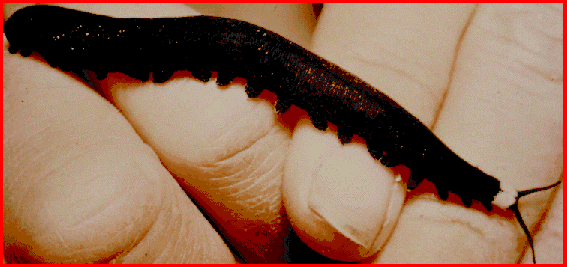To: VadeRetro
Sorry, forgot I was having this conversation.
"Are you sure?"I visited that link, thank you, it was very instructive. HoweverTwo of the points he make are fairly easily disputed.(whether they are true or not is another matter)
1. He talks about forms evolving from one distinct type to another. As his primary example he offers a fossil of a long animal with lobopods (lumpy feet for people like me)Here is one of the fossils he provides:

He does not talk about its date precisely seems to hold that its from the Vendian period (620m-540m bce)
The point he tries to make with this fossil is that it shows a worm on its way to evolving to another species, in short, a classic transitional form.
Here is a current photograph of what appears to be a very close relative, not at all fossilized, that does not seem to have "transited" anywhere:

2.(the other point that was disputable) He claimed the apparent big explosion of life in the Cambrian was misleading in that it just indicated this is when all the disparate forms all evolved shells, and their shell-less precursers did not leave fossils. There are two quick points on this. Firstly a LOT of different forms suddenly appeared. To surmise that they all evolved shells in parallel strains credulity but its certainly not an adequate refutal of the claim. The more convincing refutation, to me, occurs farther back on his own page and is the first image posted on this reply: It is a fossil from an earlier age that is soft.
It appears from his own supporting evidence that his assertions are not conclusive.
Please send more links if you have them.
Regards
v.
39 posted on
01/19/2002 5:19:08 AM PST by
ventana
To: ventana
The persistence of well-adapted forms does not disprove evolution. There are still cyanobacteria unchanged so far as we can tell from their fossil counterparts 3.5 billion years ago. This does not help you that I can see.
Yes, in highly favorable conditions, soft parts can be fossilized. As mentioned above, there are fossils of unicelluars. Occasionally with vertebrates we can see skin folds, organs, feathers, and other things that far more usually leave no trace. In fact, most animals that die leave no fossils at all. The very well preserved ones are rare, exceptional cases. So what?
To: ventana
He talks about forms evolving from one distinct type to another. As his primary example he offers a fossil of a long animal with lobopods (lumpy feet for people like me) Despite Morton's patient explanation, you miss the point that a lobopod is not an arthropod leg at all. The animal it appears on predates all that. And what about Anomalocaris, that wormy critter with arthropod parts?
A gene-level evo-devo scenario for arthropods starting from Aysheaia is presented beginning here, although I'd recommend starting at the beginning of the slideshow here.
How does looking up a modern velvet worm and going "Tah-dah" answer all this? Oh, wait! You did say something else:
2.(the other point that was disputable) He claimed the apparent big explosion of life in the Cambrian was misleading in that it just indicated this is when all the disparate forms all evolved shells, and their shell-less precursers did not leave fossils. There are two quick points on this. Firstly a LOT of different forms suddenly appeared. To surmise that they all evolved shells in parallel strains credulity but its certainly not an adequate refutal of the claim. The more convincing refutation, to me, occurs farther back on his own page and is the first image posted on this reply: It is a fossil from an earlier age that is soft.
I touched on this already. Yes, there are some "soft" fossils from before the Cambrian explosion, but they're harder to find. This is not suprising and does not help your case. It's far easier to fossilize chitin or bone than soft cellular tissue. It's unclear how many times hard parts were developed. I doubt if you need more than three: one each for mollusks, arthropods, and (rather later) vertebrates.
You've been given all sorts of evidence for the mechanisms involved and evidence that what obviously happens has happened.
What's your story?
FreeRepublic.com is powered by software copyright 2000-2008 John Robinson

